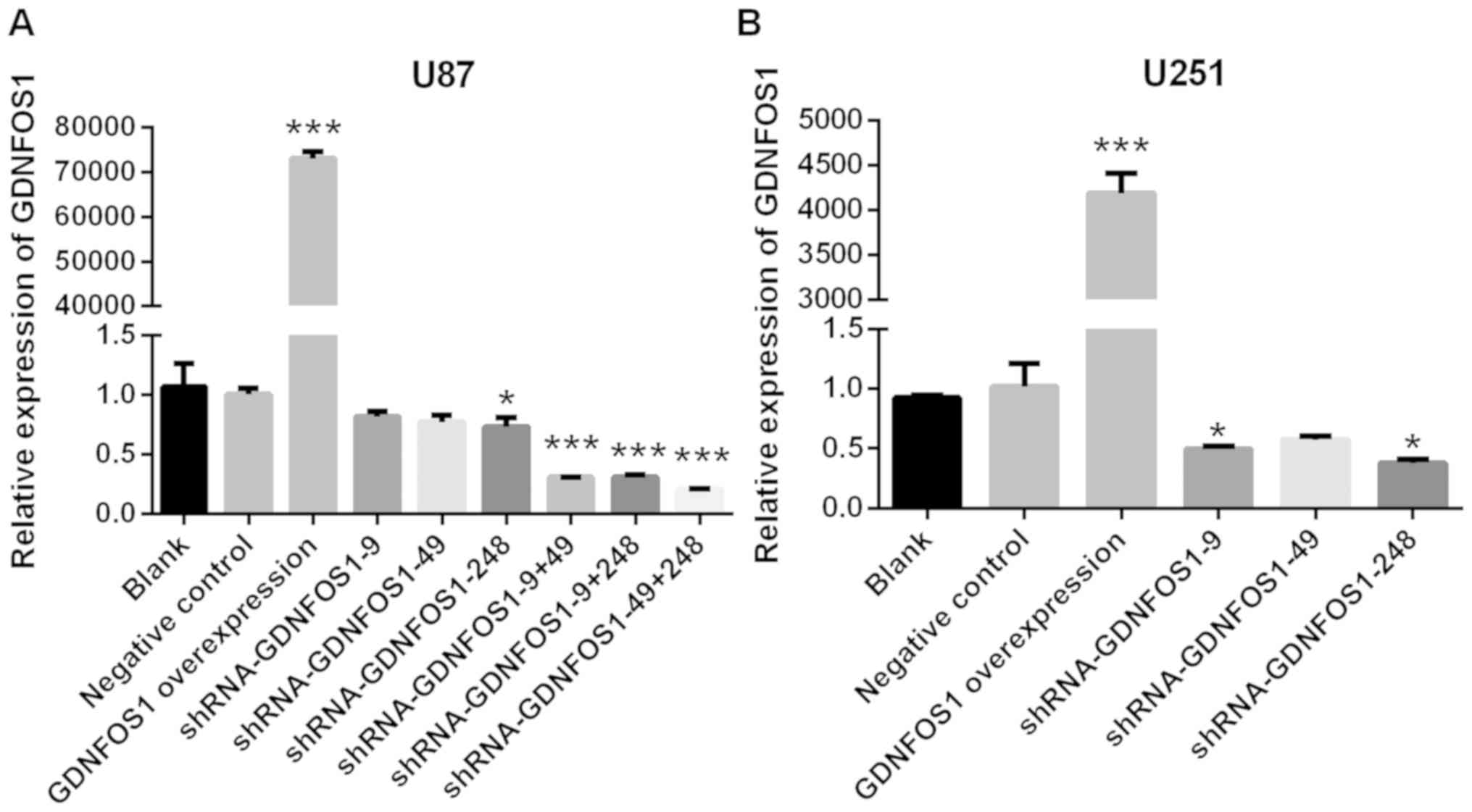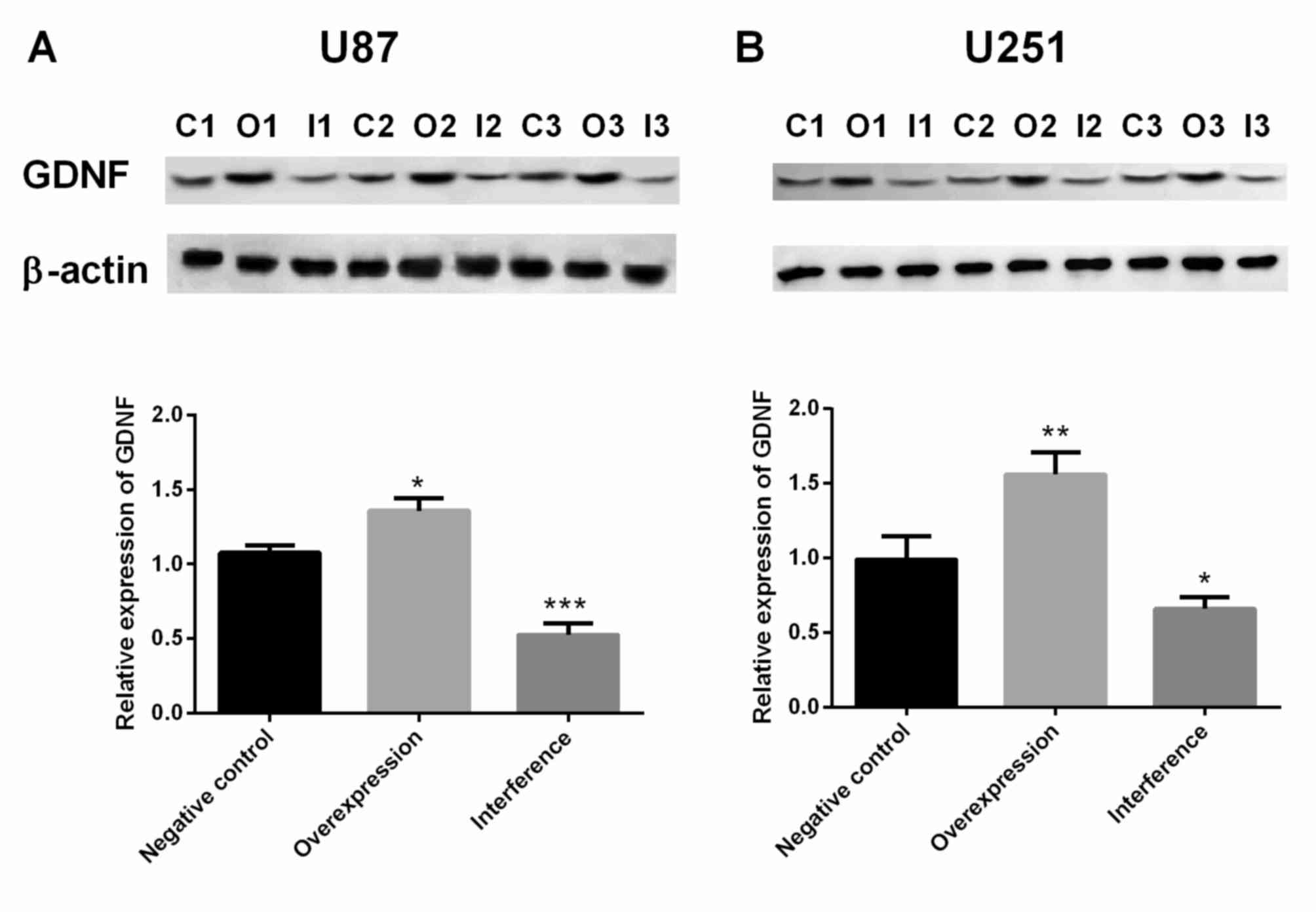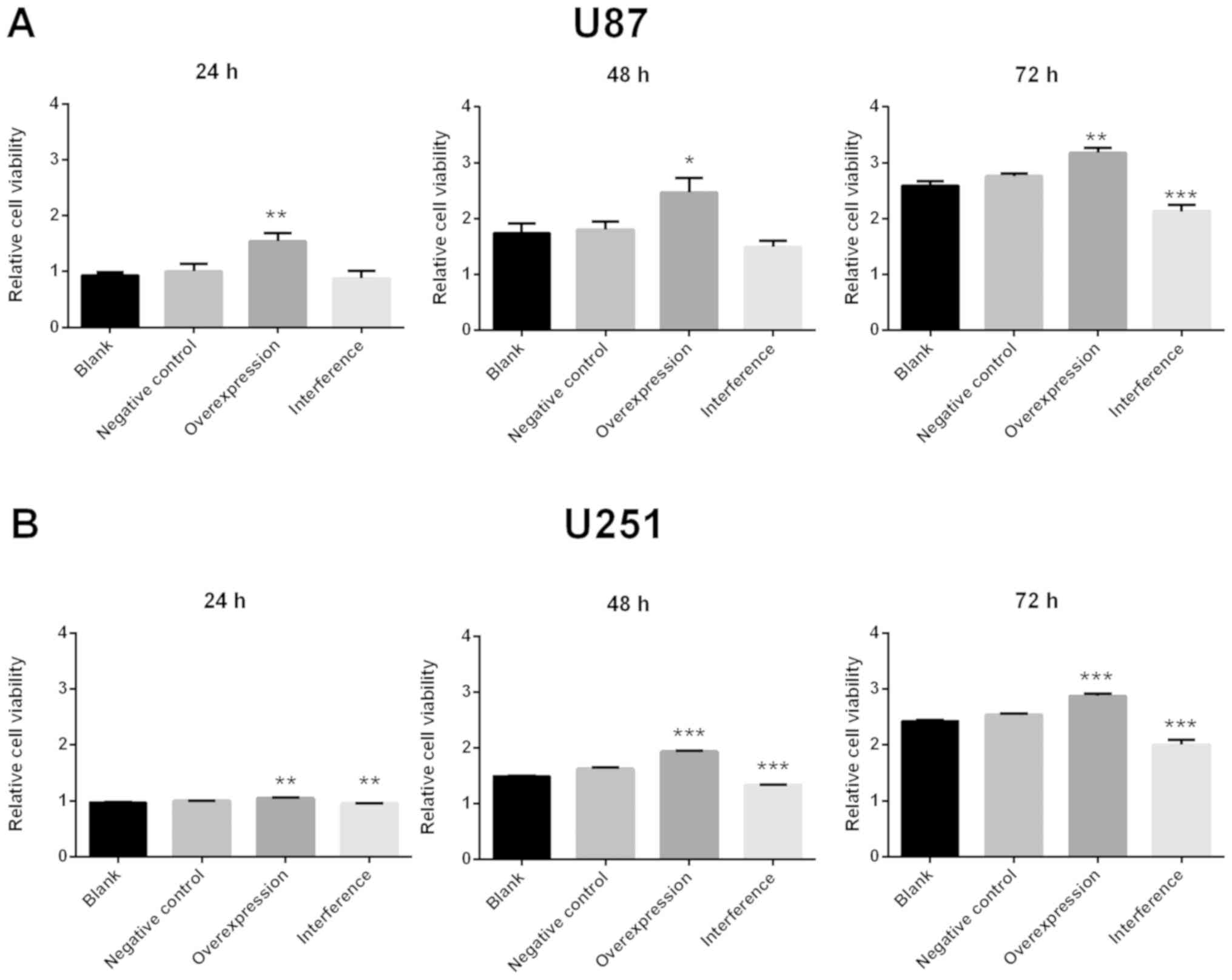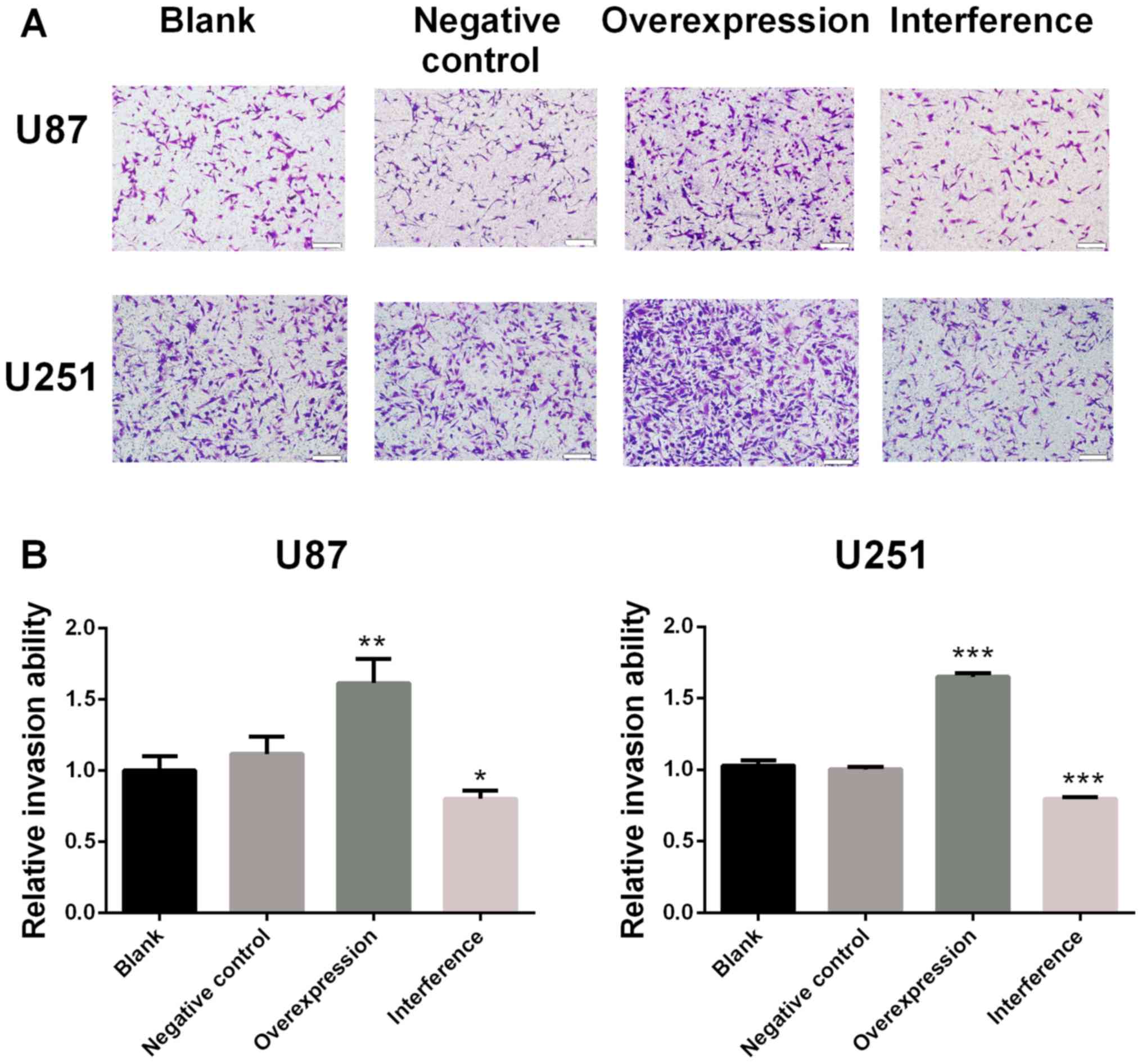|
1
|
Bleeker FE, Molenaar RJ and Leenstra S:
Recent advances in the molecular understanding of glioblastoma. J
Neurooncol. 108:11–27. 2012. View Article : Google Scholar : PubMed/NCBI
|
|
2
|
Gallego O: Nonsurgical treatment of
recurrent glioblastoma. Curr Oncol. 22:e273–e281. 2015. View Article : Google Scholar : PubMed/NCBI
|
|
3
|
Henderson CE, Phillips HS, Pollock RA,
Davies AM, Lemeulle C, Armanini M, Simmons L, Moffet B, Vandlen RA,
Simpson LC, et al: GDNF: A potent survival factor for motoneurons
present in peripheral nerve and muscle. Science. 266:1062–1064.
1994. View Article : Google Scholar : PubMed/NCBI
|
|
4
|
Lin LF, Doherty DH, Lile JD, Bektesh S and
Collins F: GDNF: A glial cell line-derived neurotrophic factor for
midbrain dopaminergic neurons. Science. 260:1130–1132. 1993.
View Article : Google Scholar : PubMed/NCBI
|
|
5
|
Arenas E, Trupp M, Akerud P and Ibáñez CF:
GDNF prevents degeneration and promotes the phenotype of brain
noradrenergic neurons in vivo. Neuron. 15:1465–1473. 1995.
View Article : Google Scholar : PubMed/NCBI
|
|
6
|
Trok K, Hoffer B and Olson L: Glial cell
line-derived neurotrophic factor enhances survival and growth of
prenatal and postnatal spinal cord transplants. Neuroscience.
71:231–241. 1996. View Article : Google Scholar : PubMed/NCBI
|
|
7
|
Airaksinen MS and Saarma M: The GDNF
family: Signalling, biological functions and therapeutic value. Nat
Rev Neurosci. 3:383–394. 2002. View
Article : Google Scholar : PubMed/NCBI
|
|
8
|
Airavaara M, Pletnikova O, Doyle ME, Zhang
YE, Troncoso JC and Liu QR: Identification of novel GDNF isoforms
and cis-antisense GDNFOS gene and their regulation in human middle
temporal gyrus of Alzheimer disease. J Biol Chem. 286:45093–45102.
2011. View Article : Google Scholar : PubMed/NCBI
|
|
9
|
Shi C, Zhang L and Qin C: Long non-coding
RNAs in brain development, synaptic biology, and Alzheimer's
disease. Brain Res Bull. 132:160–169. 2017. View Article : Google Scholar : PubMed/NCBI
|
|
10
|
Ku MC, Wolf SA, Respondek D, Matyash V,
Pohlmann A, Waiczies S, Waiczies H, Niendorf T, Synowitz M, Glass R
and Kettenmann H: GDNF mediates glioblastoma-induced microglia
attraction but not astrogliosis. Acta Neuropathol. 125:609–620.
2013. View Article : Google Scholar : PubMed/NCBI
|
|
11
|
Liu B, Chen Q, Tian D, Wu L, Dong H, Wang
J, Ji B, Zhu X, Cai Q, Wang L and Zhang S: BMP4 reverses multidrug
resistance through modulation of BCL-2 and GDNF in glioblastoma.
Brain Res. 1507:115–124. 2013. View Article : Google Scholar : PubMed/NCBI
|
|
12
|
Feng SY, Dong CG, Wu WK, Wang XJ, Qiao J
and Shao JF: Lentiviral expression of anti-microRNAs targeting
miR-27a inhibits proliferation and invasiveness of U87 glioma
cells. Mol Med Rep. 6:275–281. 2012. View Article : Google Scholar : PubMed/NCBI
|
|
13
|
Li G, Zhang H, Liu Y, Kong L, Guo Q and
Jin F: Effect of temozolomide on livin and caspase-3 in U251 glioma
stem cells. Exp Ther Med. 9:744–750. 2015. View Article : Google Scholar : PubMed/NCBI
|
|
14
|
Livak KJ and Schmittgen TD: Analysis of
relative gene expression data using real-time quantitative PCR and
the 2(-Delta Delta C(T)) method. Methods. 25:402–408. 2001.
View Article : Google Scholar : PubMed/NCBI
|
|
15
|
Trupp M, Rydén M, Jörnvall H, Funakoshi H,
Timmusk T, Arenas E and Ibáñez CF: Peripheral expression and
biological activities of GDNF, a new neurotrophic factor for avian
and mammalian peripheral neurons. J Cell Biol. 130:137–148. 1995.
View Article : Google Scholar : PubMed/NCBI
|
|
16
|
Williams LR, Inouye G, Cummins V and
Pelleymounter MA: Glial cell line-derived neurotrophic factor
sustains axotomized basal forebrain cholinergic neurons in vivo:
Dose-response comparison to nerve growth factor and brain-derived
neurotrophic factor. J Pharmacol Exp Ther. 277:1140–1151.
1996.PubMed/NCBI
|
|
17
|
Mwangi S, Anitha M, Mallikarjun C, Ding X,
Hara M, Parsadanian A, Larsen CP, Thule P, Sitaraman SV, Anania F
and Srinivasan S: Glial cell line-derived neurotrophic factor
increases beta-cell mass and improves glucose tolerance.
Gastroenterology. 134:727–737. 2008. View Article : Google Scholar : PubMed/NCBI
|
|
18
|
McKeown SJ, Mohsenipour M, Bergner AJ,
Young HM and Stamp LA: Exposure to GDNF enhances the ability of
enteric neural progenitors to generate an enteric nervous system.
Stem Cell Reports. 8:476–488. 2017. View Article : Google Scholar : PubMed/NCBI
|
|
19
|
Worley DS, Pisano JM, Choi ED, Walus L,
Hession CA, Cate RL, Sanicola M and Birren SJ: Developmental
regulation of GDNF response and receptor expression in the enteric
nervous system. Development. 127:4383–4393. 2000.PubMed/NCBI
|
|
20
|
Schiltz CA, Benjamin J and Epstein ML:
Expression of the GDNF receptors ret and GFRalpha1 in the
developing avian enteric nervous system. J Comp Neurol.
414:193–211. 1999. View Article : Google Scholar : PubMed/NCBI
|
|
21
|
Chalazonitis A, Rothman TP, Chen J and
Gershon MD: Age-dependent differences in the effects of GDNF and
NT-3 on the development of neurons and glia from neural
crest-derived precursors immunoselected from the fetal rat gut:
Expression of GFRalpha-1 in vitro and in vivo. Dev Biol.
204:385–406. 1998. View Article : Google Scholar : PubMed/NCBI
|
|
22
|
Du F, Wang L, Qian W and Liu S: Loss of
enteric neurons accompanied by decreased expression of GDNF and
PI3K/Akt pathway in diabetic rats. Neurogastroenterol Motil.
21:1229–e114. 2009. View Article : Google Scholar : PubMed/NCBI
|
|
23
|
Du F and Liu S: Electroacupuncture with
high frequency at acupoint ST-36 induces regeneration of lost
enteric neurons in diabetic rats via GDNF and PI3K/AKT signal
pathway. Am J Physiol Regul Integr Comp Physiol. 309:R109–R118.
2015. View Article : Google Scholar : PubMed/NCBI
|
|
24
|
Bottner M, Harde J, Barrenschee M, Hellwig
I, Vogel I, Ebsen M and Wedel T: GDNF induces synaptic vesicle
markers in enteric neurons. Neurosci Res. 77:128–136. 2013.
View Article : Google Scholar : PubMed/NCBI
|
|
25
|
Oh-hashi K, Kaneyama M, Hirata Y and
Kiuchi K: ER calcium discharge stimulates GDNF gene expression
through MAPK-dependent and -independent pathways in rat C6
glioblastoma cells. Neurosci Lett. 405:100–105. 2006. View Article : Google Scholar : PubMed/NCBI
|
|
26
|
Suter-Crazzolara C and Unsicker K: GDNF
mRNA levels are induced by FGF-2 in rat C6 glioblastoma cells.
Brain Res Mol Brain Res. 41:175–182. 1996. View Article : Google Scholar : PubMed/NCBI
|
|
27
|
Verity AN, Wyatt TL, Lee W, Hajos B,
Baecker PA, Eglen RM and Johnson RM: Differential regulation of
glial cell line-derived neurotrophic factor (GDNF) expression in
human neuroblastoma and glioblastoma cell lines. J Neurosci Res.
55:187–197. 1999. View Article : Google Scholar : PubMed/NCBI
|
|
28
|
Akella A, Bhattarai S and Dharap A: Long
noncoding RNAs in the pathophysiology of ischemic stroke.
Neuromolecular Med; 2019, View Article : Google Scholar
|
|
29
|
Bakhtiarizadeh MR and Salami SA:
Identification and expression analysis of long noncoding RNAs in
fat-tail of sheep breeds. G3 (Bethesda). 9:1263–1276.
2019.PubMed/NCBI
|
|
30
|
Zhang Y, Liu XS, Liu QR and Wei L:
Genome-wide in silico identification and analysis of cis natural
antisense transcripts (cis-NATs) in ten species. Nucleic Acids Res.
34:3465–3475. 2006. View Article : Google Scholar : PubMed/NCBI
|
|
31
|
Tang CX, Gu YX, Liu XF, Tong SY, Ayanlaja
AA, Gao Y, Ji GQ, Xiong Y, Huang LY and Gao DS: Cross-link
regulation of precursor N-cadherin and FGFR1 by GDNF increases
U251MG cell viability. Oncol Rep. 40:443–453. 2018.PubMed/NCBI
|
|
32
|
Cui L, Fang L, Mao X, Chang HM, Leung PCK
and Ye Y: GDNF-induced downregulation of miR-145-5p enhances human
oocyte maturation and cumulus cell viability. J Clin Endocrinol
Metab. 103:2510–2521. 2018. View Article : Google Scholar : PubMed/NCBI
|
|
33
|
Clarkson ED, Zawada WM and Freed CR: GDNF
reduces apoptosis in dopaminergic neurons in vitro. Neuroreport.
7:145–149. 1995. View Article : Google Scholar : PubMed/NCBI
|
|
34
|
McAlhany RE Jr, West JR and Miranda RC:
Glial-derived neurotrophic factor (GDNF) prevents ethanol-induced
apoptosis and JUN kinase phosphorylation. Brain Res Dev Brain Res.
119:209–216. 2000. View Article : Google Scholar : PubMed/NCBI
|
|
35
|
Cavel O, Shomron O, Shabtay A, Vital J,
Trejo-Leider L, Weizman N, Krelin Y, Fong Y, Wong RJ, Amit M and
Gil Z: Endoneurial macrophages induce perineural invasion of
pancreatic cancer cells by secretion of GDNF and activation of RET
tyrosine kinase receptor. Cancer Res. 72:5733–5743. 2012.
View Article : Google Scholar : PubMed/NCBI
|
|
36
|
He S, Chen CH, Chernichenko N, He S, Bakst
RL, Barajas F, Deborde S, Allen PJ, Vakiani E, Yu Z and Wong RJ:
GFRα1 released by nerves enhances cancer cell perineural invasion
through GDNF-RET signaling. Proc Natl Acad Sci USA.
111:E2008–E2017. 2014. View Article : Google Scholar : PubMed/NCBI
|
|
37
|
Bhakta S, Crocker LM, Chen Y, Hazen M,
Schutten MM, Li D, Kuijl C, Ohri R, Zhong F, Poon KA, et al: An
Anti-GDNF family receptor alpha 1 (GFRA1) antibody-drug conjugate
for the treatment of hormone receptor-positive breast cancer. Mol
Cancer Ther. 17:638–649. 2018. View Article : Google Scholar : PubMed/NCBI
|
|
38
|
Wang Y, Li Z, Zhang H, Jin H, Sun L, Dong
H, Xu M, Zhao P, Zhang B, Wang J, et al: HIF-1α and HIF-2α
correlate with migration and invasion in gastric cancer. Cancer
Biol Ther. 10:376–382. 2010. View Article : Google Scholar : PubMed/NCBI
|
|
39
|
Gao J, Yu SR, Yuan Y, Zhang LL, Lu JW,
Feng JF and Hu SN: MicroRNA-590-5p functions as a tumor suppressor
in breast cancer conferring inhibitory effects on cell migration,
invasion and epithelial-mesenchymal transition by downregulating
the Wnt-β-catenin signaling pathway. J Cell Physiol. 234:1827–1841.
2019. View Article : Google Scholar : PubMed/NCBI
|
|
40
|
Wu D, Liu J, Chen J, He H, Ma H and Lv X:
miR-449a suppresses tumor growth, migration and invasion in
non-small cell lung cancer by targeting a HMGB1-mediated NF-κB
signaling pathway. Oncol Res. 27:227–235. 2019. View Article : Google Scholar : PubMed/NCBI
|
|
41
|
Mansoori B, Mohammadi A, Ghasabi M,
Shirjang S, Dehghan R, Montazeri V, Holmskov U, Kazemi T, Duijf P,
Gjerstorff M and Baradaran B: miR-142-3p as tumor suppressor miRNA
in the regulation of tumorigenicity, invasion and migration of
human breast cancer by targeting Bach-1 expression. J Cell Physiol.
234:9816–9825. 2019. View Article : Google Scholar : PubMed/NCBI
|
|
42
|
Sano M, Ijichi H, Takahashi R, Miyabayashi
K, Fujiwara H, Yamada T, Kato H, Nakatsuka T, Tanaka Y, Tateishi K,
et al: Blocking CXCLs-CXCR2 axis in tumor-stromal interactions
contributes to survival in a mouse model of pancreatic ductal
adenocarcinoma through reduced cell invasion/migration and a shift
of immune-inflammatory microenvironment. Oncogenesis. 8:82019.
View Article : Google Scholar : PubMed/NCBI
|


















